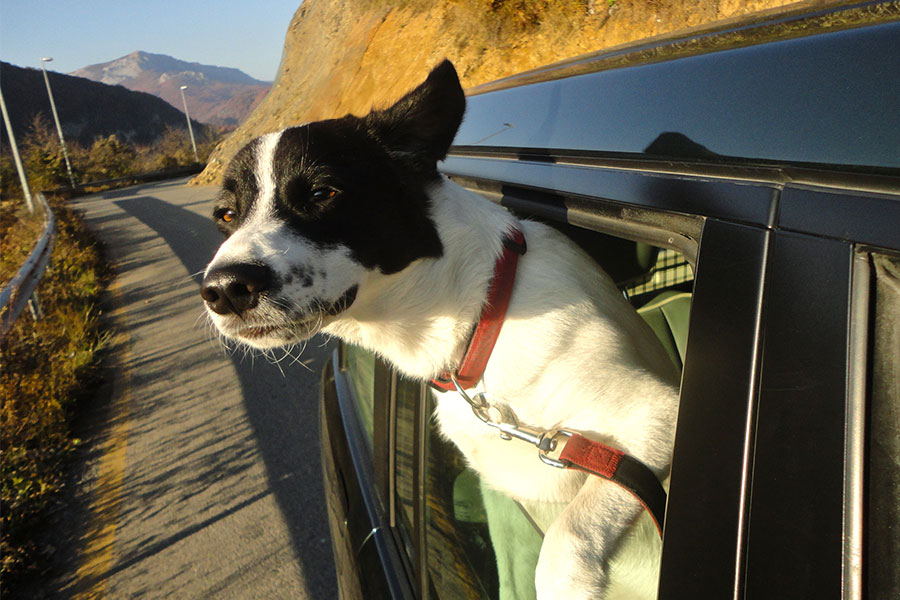
Photo: Capuski/Getty Images
Embarking: What You Need to Know When Travelling With Your Pet
BY Viia Beaumanis | October 2nd, 2023
We want to take our dogs everywhere, including on vacation. But while lodging options are becoming increasingly pet friendly, new transportation regulations are making it more difficult to travel with Fido.
From hotels and trains to international flights, information and preparation are the keys to successfully travelling with your fur baby. (For this article, we’ll focus on dogs as most of us aren’t bringing cats, cockatoos, snakes or rabbits on holiday.)
The first thing you need to consider before you go is whether your pet might actually be happier staying home. Not all dogs are made for travel, no matter how well prepared you are or how much you may miss them. If they are anxious or easily stressed, nervous about crowds or strangers, they’ll be much happier at home with someone walking and feeding them.
Secondly, not every vacation is improved by bringing your dog along. Does your trip include lots of places that don’t allow animals, like museums, cultural institutions, restaurants, theatres or theme parks? And, some destinations are far more pet-friendly than others: Dogs are welcome essentially everywhere in Europe, including inside fancy restaurants in many cases (Hello France and Italy!), while across Canada and the U.S., you’ll often have a hard time getting them onto a patio.
Pet Passports
That goes for ground transportation as well – the EU issues pet passports. EuroRail allows dogs of all sizes on board, charging either a child’s fee or half the standard fare for larger ones.
But across North America, it’s now impossible to get a dog onto a train (or Greyhound-type bus), unless it’s under 20 pounds – or sporting medical support paperwork. VIA Rail has stopped accommodating crated dogs in baggage cars, and won’t let larger ones in seating areas, just small dogs in carriers. Same with Amtrak in the U.S. As of 2021, the U.S. Department of Transportation stopped requiring airlines to accept emotional support animals – only service dogs are allowed in the cabin, or those under 20 pounds.
Canadian airline regulations concerning pets have also been amended. Carriers can now refuse to board emotional support animals and Air Canada has banned them altogether. As have many other airlines, including American Airlines, Delta, and United. The season impacts animal travel as well. Policies vary but most airlines don’t ship live animals in baggage or cargo if temperatures are below 7 C or above 29 C during departure, arrival, or while making connections.
Paperwork
Countries differ widely in their rules and regulations for animal entry. After confirming that the country you’re travelling to doesn’t require a pet quarantine (like Australia) or an arduous process to avoid quarantine (such as Hawaii), check if the country requires that your pet be microchipped. Travelling from Canada, your dog will definitely need a rabies vaccine confirmation. If it’s out of date, that shot must be administered not less than a month before travel. You’ll also have to obtain the standard Health Certificate provided by your vet, which needs to be signed within 10 days of your departure.
See if you need a permit for the country that you’re visiting. Some, like the Bahamas, require that you apply for one before entering, which involves their office of agriculture faxing you forms (yes, faxing!), which you mail or courier back with a fee. Others simply ask that you have the required health forms on arrival.

Also, check the list of banned breeds. Most people are aware that pit bulls aren’t permitted to enter other countries, but did you know American Staffordshire Terriers are prohibited in many places including Denmark and Puerto Rico or that Israel says no to Rottweilers?
Crating in Cargo
Unless your dog is under nine kg (20 lbs) – in which case, book a bulkhead seat so you have extra legroom – you’ll have to crate them in the cargo hold. Crates need to be large enough for the dog to stand, turn and lie down. Confirm that it meets the airline’s requirements, they vary by carrier. Line it with a pee pad, just in case, as well as a cozy blanket from home that smells like you. (Buy a cheap one and sleep with it for a week before you leave.) Stock the crate with a favourite stuffed animal; something to chew on that’s distracting (like a treat puzzle ball loaded with snacks the dog has to ferret out); and attach a water dispenser.
When flying, especially internationally, double-check airline pet policies as they are constantly in flux. Make the reservation by phone to confirm every detail, including where you check the animal in, which can differ from where you check yourself in. The cost to ship a crated dog can be as low as $200 or as much as $600. Plan to get to the airport early, at least three hours before your flight so everything goes calmly and smoothly.
Consider giving your dog something calming for the trip. Avoid sedatives, which can make pets feel woozy and off balance, thus causing them more unease. Ask your vet to prescribe an anti-anxiety medication like trazodone or alprazolam (Xanax). Or go with something natural. Valerian, an herbal used by humans for insomnia, is the main ingredient in PetRemedy, which has been proven to calm dogs. There are also numerous CBD calming products that relax animals for air travel.
Start medicating your pet several hours before you leave, even the evening before if you have an early morning flight so they’re nice and chill. If possible, book a later flight and give your dog lots of exercise to burn off energy before you leave. Also, skip the last meal you’d normally feed them. A common symptom of stress is diarrhea and simple motion sickness can upset your animal’s stomach.
Hotels and Apps
Research the hotels at your destination that allow dogs. Some (Fairmont and Kimpton) pride themselves as being pet friendly. Some have size restrictions or charge fees that can really add up. If you book a hotel with a $50/night pet fee for a week, that’s an additional $350. Can’t find a good hotel in the area? Try airbnb.com – they have search function that filters for pet-friendly homes.
There are plenty of apps that can help when travelling with your dog from All Trails, which has the largest collection of trail maps (over 50,000) to Bring Fido helps you locate nearby hotels, attractions, and restaurants that welcome pets.
Finally, be prepared for an emergency. Find the number of the nearest 24-hour veterinary and emergency animal hospital and program it into your mobile, along with the office and emergency number for your hometown veterinarian (in case the vets need to speak with each other). That way, if there’s a situation where your dog needs medical attention, you have the necessary information on hand to deal with things as swiftly as possible.
Are you looking to find a vacation rental or buy or sell a vehicle for your next trip? Browse the Zone Classifieds and post your ad here.
Classified Deals

ITALY'S HIDDEN TREASURES: TAILORED TRAVEL EXPERIENCES
Tailored travel experiences away from increasing crowdsPOSTED November 21st, 2023
Italy

STAY IN WINE COUNTRY
Niagara-on-the-Lake - 2-bedroom house in a spectacular location!POSTED November 15th, 2023
Niagara-on-the-Lake , ON


